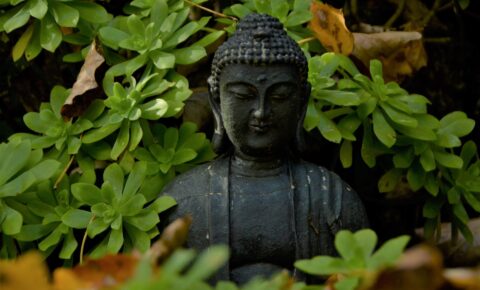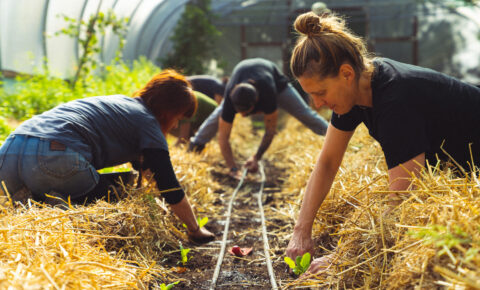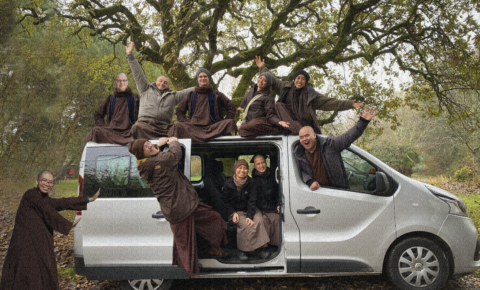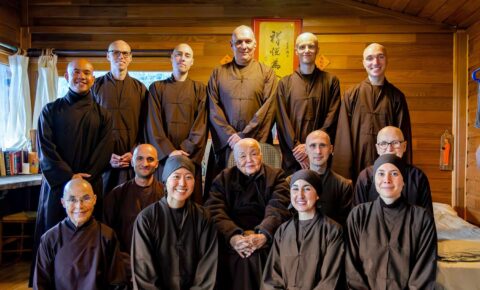First Summer Opening in Plum Village
In 1983, we held our first Summer Opening with 117 practitioners. We had not yet developed the practice of Touching the Earth or the daily practice with gathas (meditation poems). However, we already had sitting meditation, walking meditation, tea meditation, and consultations. There were no monks and nuns yet, so I led all the practices from the beginning to the end, from A to Z. I walked around and corrected people’s sitting posture, straightening each person’s back and neck. During our first Summer Retreat, there were a few Westerners among the many Vietnamese people.
In the second Summer Opening, there were 232 people. In the third, 305, the seventh, 483, and in the ninth, there were 1,030. In 1996, 1200 people came for the Summer Retreat, and in 1998, there were 1,450 practitioners. In the year 2000, the number increased to 1,800. Of course, not all 1,800 came at the same time. Some came for one, two, or three weeks, and some came for the entire four weeks of the retreat. There were those who liked it so much, that after four weeks, they asked to stay on longer. People came throughout the year to practice with us. In the first few years, Western practitioners stayed in the Lower Hamlet so they could enjoy traditional dishes of their homeland.
The Atlantic cedars, which you see in the Upper Hamlet, were planted during the first year. They were just four feet tall and took a long time to grow, but the more they grew, the more beautiful they became. They will be very beautiful in three hundred years’ time. There are two different varieties of Atlantic cedars; one is a smoky gray color and the other is a silvery-blue. When we do walking meditation in the Upper Hamlet, we start at the linden tree. As we pass the Transformation Meditation Hall, we see the Atlantic cedars on the right. They are already so beautiful. I often look at a tree and see it as a monk or a nun who is growing strong in Plum Village. I stop to offer praise, “This young novice is doing quite well!” because that particular cedar tree has grown healthily and beautifully. Twenty years have passed, and they are now grown – no longer four-foot high baby cedar trees. In Plum Village, many other things have grown up as well. Not only the monks and nuns and lay practitioners have grown up, but also our methods of practice, our experiences, and the lessons from our own practices have matured, like the cedars.
The Signless Nature of Plum Village
In 1983, standing on the hill, I could already envision the plum trees in flower, covering the whole land in sprays of white. That was the sight I saw in the ultimate dimension. Within four years, when the spring arrived, the plum trees really did blossom so beautifully.
Many are surprised when they come to Plum village that it is not what they had imagined. For example, we had forewarned a delegation from the Buddhist Association of China before their arrival in Plum Village that we had only trees, old farmhouses and cow barns converted into meditation halls and living quarters. We told them this many times, but when they arrived, they were still surprised. They had not expected Plum Village to be so poor, so simple, and rustic. Each one of us has a different understanding of Plum Village.
Brother Phap Can grew up and studied in Germany and came to Plum Village to be ordained. Last year, he went back to Germany with a delegation from Plum Village, and he discovered a new Germany. When he had lived in Germany, he had never been in touch with the Plum Village Sangha there. But returning, he encountered a large number of Vietnamese and German people following the practices of Plum Village. There were Dharma talks that three thousand and seven thousand German people attended. There were walking meditation processions with hundreds of German people walking together. He discovered a completely new Germany. Plum Village exists in Germany, but he had never seen it during the seven or eight years he lived there. We have to find the truth with the eye of signlessness. Plum Village elements exist everywhere; they exist in our own hearts.
Coming to Plum Village with a camcorder does not necessarily mean that you can record Plum Village. Plum Village is not a Vietnamese temple set on European land. In Plum Village, we can see Indian culture, Chinese culture, Vietnamese culture, and Western culture. When we look carefully, we see that non-Plum Village elements exist in Plum Village. Consequently, Plum Village is also an object of meditation. The deeper we look, the more clearly we see it. Otherwise, looking at Plum Village, we only have a superficial and vague notion about Plum Village. If we look deeply, we see that Plum Village is also unborn and undying.
A few years ago, we went to visit the Jeta Grove in India, one of the places where the Buddha lived. We saw that the Jeta Grove Monastery was no longer there. Japanese archeologists came to excavate the area, and discovered remnants of many large monasteries adjacent to one another, buried under the Earth. They could identify the places the monks slept, the Buddha hall, the teaching hall, and so on. Yet, we know that the Jeta Grove has never died, because when we go to other countries like Japan, China, Korea, and Tibet, we see the Jeta Grove is still there in its new forms. Thus, the true nature of the Jeta Grove is that of no-birth and no-death. Plum Village is the same. For example, if tomorrow Plum Village were to be closed down, and people built large shopping malls in the Lower Hamlet and the Upper Hamlet, Plum Village would still exist, in its new manifestations everywhere, especially in our hearts. When we come to Plum Village, we must look deeply to see its nature of no-birth and no-death; we must see the reality of Plum Village beyond all forms.






Join the conversation